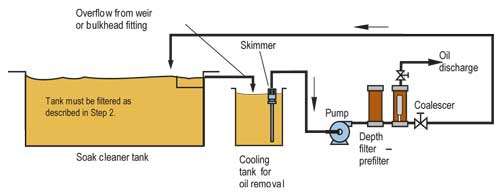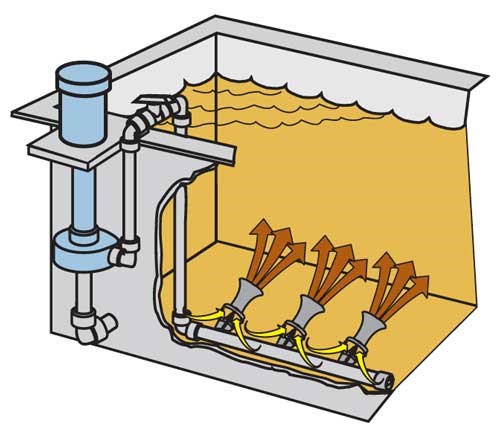An Innovative Approach to Filtration (Without Aggravation)
Achieve better deposits, lower reject rates and longer solution life.
Filtration without aggravation is the key to designing any system needed to effectively remove contaminants from a finishing solution.
#pollutioncontrol #basics
Filtration without aggravation is the key to designing any system needed to effectively remove contaminants from a finishing solution. The term ‘turnover’ has been the benchmark for any system employed to remove both solid and organic impurities. If ten kids fall into a swimming pool, how long will it take one lifeguard to save all ten? Wouldn’t ten lifeguards guarantee quicker results? The same is true for filtration equipment, which is designed to remove particulates and organics from the finishing process.
The use of metallic surface finishing for aesthetic and functional reasons will always have a place in our design-conscious world. It should, therefore, be done to the best of the finisher’s ability, along with responsible compliance to regulations. The plater must take these concerns into account when selecting finishing equipment.
Featured Content
We have heard over and over that turnover rates must be high. Filtration rates of one, two or even three turnovers per hour are no longer acceptable. Higher turnovers bring the contaminated solution to the filter more quickly. The higher the turnover rate, the quicker the solids will be removed. Higher turnover rates will allow the use of coarser filter media, which has more dirt-holding capacity, which in turn reduces back pressure and ensures that the desired flow rate can be maintained.
If organics are present, they must be treated separately. The use of powdered carbon mixed with filter aid will not effectively remove organics. Carbon adsorption requires considerable contact time for proper removal of organic contamination.
The continued use of (activated) powdered carbon in the metal finishing industry is detrimental for several reasons. First, powdered carbon is a hazardous substance, because it may contain compounds which are carcinogenic. Second, it is a solid just like the particles that you are trying to remove from the process solution. Powdered carbon will plug up your filter prematurely, requiring frequent servicing. Third, powdered carbon is not a filter aid. Particulate contamination will blind off the porous surface of carbon, which in turn increases the pressure drop while reducing the flow rate.
The above simply clarifies why metal finishers have encountered the high cost of frequent servicing of disc filters, needless solution loss during servicing and the necessity to batch carbon treat to remove the build-up of organic contamination.
The Answers are Obvious
First, reduce the chances of organic substances (like oil, rust inhibitors, drawing compounds, etc.) traveling from the cleaner to the rinses to the acid to the final rinse before your parts enter the finishing process. Filtration, coalescing and/or purification of the preplate line will reduce over 80% of the contaminants, before they can reach the process tank. The cost of the equipment required to achieve this is minimal when compared with the results that will be achieved.
Second, eliminate the use of air agitation, which is constantly introducing airborne contamination into your process tank and could be causing addition agents to break down, thus resulting in significant organic contamination. Switch to eductor agitation and place a chamber with canisters of granular carbon downstream from your process filter.
Pre-filtering, provided by the process filter, prevents particulates from coming into contact with the porous surfaces of the granular carbon. The use of granular carbon purification could eliminate the need to batch carbon treat solutions to remove organic impurities.
Earlier we mentioned the importance of "turnover" as related to filtration and purification. It should be noted that filtration turnovers will not replace an engineered agitation system. Solution agitation requires the use of a pump along with strategically placed eductor nozzles designed to recirculate solution.
The use of pumps and eductor nozzles should be used to replace air agitation for several reasons:
- Eductor agitation does not introduce airborne emissions into the process solution, reducing the amount of contamination that the filtration system must remove.
- Eductor agitation will not cause organic brighteners to break down, resulting in consistently higher quality deposits and fewer rejects.
- Eductor agitation can improve coverage in low current density (LCD) areas, thus producing a more uniform deposit, and minimizing costly over-plate, which is often necessary to achieve minimum deposition requirements.
- Eductor agitation permits plating at higher current densities for faster plating rates, resulting in improved productivity.
Recommendations
Do these suggestions recommend a “finishing line of the future”?
- Less frequent dumping of ‘spent’ process chemistry
- Reduced drag-out of contaminants
- Improved overall quality promotes the use of surface finishing
- Less technical service and laboratory analysis
- Higher productivity
- Fewer rejects and less rework
- Lower cost = more profit.
One plater recently told me that by installing an eductor system he was able to increase his amperage by 25%, which allowed him to plate 33% faster. He said that this made it possible to increase his production capacity by $213,000/yr on this line, without having to purchase any additional equipment (other than the eductor system). Not a bad investment, considering the relatively small expenditure that he made for the installation of the eductor system.
RELATED CONTENT
-
Choosing and Troubleshooting Copper Electroplating Processes
Learn more on this inexpensive and highly efficient process.
-
Stripping of Plated Finishes
The processes, chemicals and equipment, plus control and troubleshooting.
-
Nickel Electroplating
Applications, plating solutions, brighteners, good operating practices and troubleshooting.




















